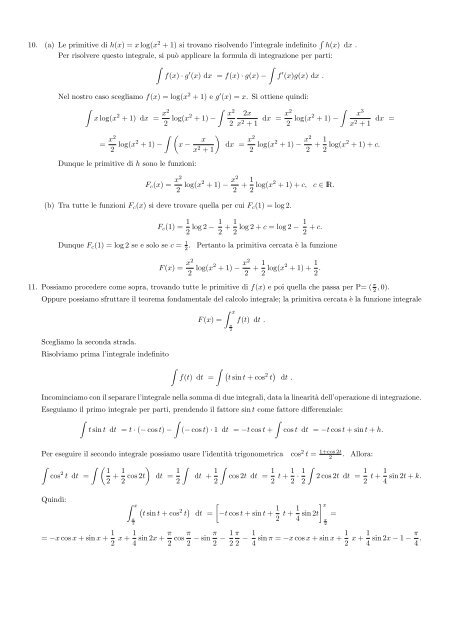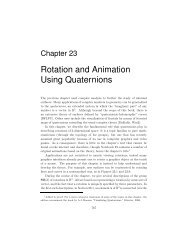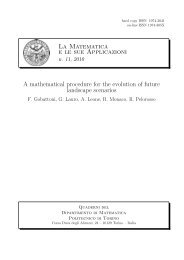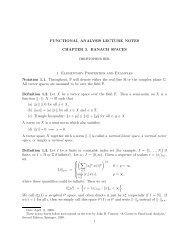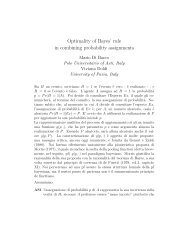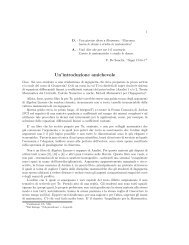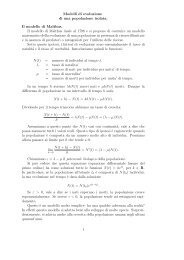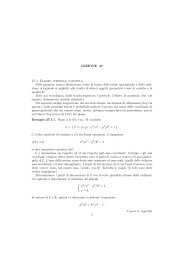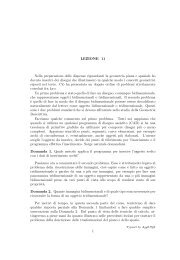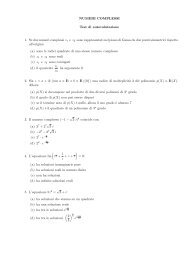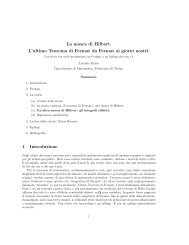INTEGRALI INDEFINITI e DEFINITI Esercizi risolti 1. E' data la ...
INTEGRALI INDEFINITI e DEFINITI Esercizi risolti 1. E' data la ...
INTEGRALI INDEFINITI e DEFINITI Esercizi risolti 1. E' data la ...
Create successful ePaper yourself
Turn your PDF publications into a flip-book with our unique Google optimized e-Paper software.
10. (a) Le primitive di h(x) = x log(x2 + 1) si trovano risolvendo l’integrale indefinito h(x) dx .<br />
Per risolvere questo integrale, si può applicare <strong>la</strong> formu<strong>la</strong> di integrazione per parti:<br />
<br />
f(x) · g ′ <br />
(x) dx = f(x) · g(x) − f ′ (x)g(x) dx .<br />
Nel nostro caso scegliamo f(x) = log(x 2 + 1) e g ′ (x) = x. Si ottiene quindi:<br />
<br />
x log(x 2 + 1) dx = x2<br />
2 log(x2 2 x<br />
+ 1) −<br />
2<br />
= x2<br />
2 log(x2 <br />
+ 1) − x − x<br />
x2 <br />
+ 1<br />
Dunque le primitive di h sono le funzioni:<br />
2x<br />
x 2 + 1<br />
x2<br />
dx =<br />
2 log(x2 <br />
+ 1) −<br />
x 3<br />
x 2 + 1<br />
dx = x2<br />
2 log(x2 + 1) − x2 1<br />
+<br />
2 2 log(x2 + 1) + c.<br />
Fc(x) = x2<br />
2 log(x2 + 1) − x2 1<br />
+<br />
2 2 log(x2 + 1) + c, c ∈ IR.<br />
(b) Tra tutte le funzioni Fc(x) si deve trovare quel<strong>la</strong> per cui Fc(1) = log 2.<br />
Fc(1) = 1 1 1<br />
1<br />
log 2 − + log 2 + c = log 2 − + c.<br />
2 2 2 2<br />
Dunque Fc(1) = log 2 se e solo se c = 1<br />
2 . Pertanto <strong>la</strong> primitiva cercata è <strong>la</strong> funzione<br />
F (x) = x2<br />
2 log(x2 + 1) − x2 1<br />
+<br />
2 2 log(x2 + 1) + 1<br />
2 .<br />
1<strong>1.</strong> Possiamo procedere come sopra, trovando tutte le primitive di f(x) e poi quel<strong>la</strong> che passa per P= ( π<br />
2 , 0).<br />
Oppure possiamo sfruttare il teorema fondamentale del calcolo integrale; <strong>la</strong> primitiva cercata è <strong>la</strong> funzione integrale<br />
x<br />
F (x) = f(t) dt .<br />
Scegliamo <strong>la</strong> seconda strada.<br />
Risolviamo prima l’integrale indefinito<br />
<br />
π<br />
2<br />
<br />
t 2<br />
f(t) dt = sin t + cos t dt .<br />
dx =<br />
Incominciamo con il separare l’integrale nel<strong>la</strong> somma di due integrali, <strong>data</strong> <strong>la</strong> linearità dell’operazione di integrazione.<br />
Eseguiamo il primo integrale per parti, prendendo il fattore sin t come fattore differenziale:<br />
<br />
<br />
<br />
t sin t dt = t · (− cos t) − (− cos t) · 1 dt = −t cos t + cos t dt = −t cos t + sin t + h.<br />
Per eseguire il secondo integrale possiamo usare l’identità trigonometrica cos 2 t =<br />
<br />
cos 2 t dt =<br />
Quindi:<br />
<br />
1 1<br />
+ cos 2t<br />
2 2<br />
dt = 1<br />
<br />
2<br />
dt + 1<br />
<br />
2<br />
x 2<br />
t sin t + cos t dt =<br />
= −x cos x + sin x + 1 1 π π π<br />
x + sin 2x + cos − sin<br />
2 4 2 2 2<br />
π<br />
2<br />
cos 2t dt = 1<br />
<br />
1 1<br />
t + ·<br />
2 2 2<br />
<br />
−t cos t + sin t + 1<br />
2<br />
x 1<br />
t + sin 2t<br />
4 π<br />
2<br />
1+cos 2t<br />
2 . Allora:<br />
2 cos 2t dt = 1 1<br />
t + sin 2t + k.<br />
2 4<br />
1 π 1<br />
1 1<br />
π<br />
− − sin π = −x cos x + sin x + x + sin 2x − 1 −<br />
2 2 4 2 4 4 .<br />
=


